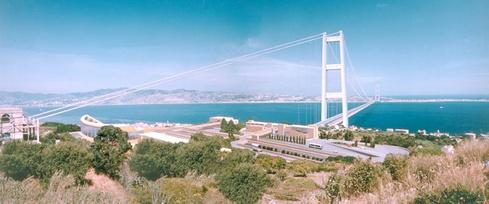After centuries of debate and planning, Italy stands on the brink of a monumental infrastructure project that could finally link the mainland to the island of Sicily. The long-envisioned bridge, which has been discussed since the 19th century, promises to transform transportation and economic connectivity across the Strait of Messina. With renewed political will and advancing engineering technologies, this ambitious undertaking could soon move from concept to reality, ushering in a new era for the region.
Italy’s Longstanding Quest to Connect the Mainland and Sicily Faces Renewed Momentum
Decades of debate and numerous failed proposals have long characterized Italy’s ambition to physically unite its mainland with Sicily. Recent political commitment and advances in engineering technology have rekindled hopes of completing the iconic bridge, a project seen not only as an infrastructural marvel but also as a symbolic gesture of national unity. Experts emphasize that the endeavor will confront immense challenges, from environmental concerns in the Strait of Messina to the complex logistics of construction over one of Europe’s busiest maritime passages.
Key advantages of the project include:
- Economic Boost: Enhancing trade and travel between Sicily and the mainland could stimulate local economies and tourism.
- Reduced Travel Times: A direct link would considerably shorten journey durations compared to current ferry services.
- Strategic Importance: Strengthening transport networks supports Italy’s broader infrastructure goals and integration within the Mediterranean region.
| Aspect | Details |
|---|---|
| Bridge Length | Approx. 3.3 km |
| Estimated Cost | €6 billion |
| Projected Completion | 2030s |
| Key Challenge | Seismic Activity |
Engineering Challenges and Environmental Concerns Shape the Future of the Sicily Bridge Project
The proposed bridge connecting mainland Italy to Sicily represents not only an engineering milestone but also a monumental environmental challenge. Spanning over 3.3 kilometers across the Strait of Messina, engineers face the daunting task of designing structures resilient to seismic activity, strong marine currents, and high winds typical of the region. The project demands cutting-edge materials and innovative construction techniques to ensure durability without compromising safety. Additionally, logistical hurdles, such as transporting massive components and coordinating work amidst turbulent waters, require meticulous planning and advanced technology.
Environmentalists and local communities have raised concerns about the potential impacts:
- Disruption of marine ecosystems and habitats
- Risks to endangered species endemic to the Strait
- Possible increase in pollution during and after construction
- Long-term changes in coastal erosion patterns
| Challenge | Potential Impact | Mitigation Strategy |
|---|---|---|
| Seismic Activity | Structural damage risk | Flexible foundation design |
| Marine Biodiversity | Loss of habitats | Environmental monitoring & protected zones |
| Pollution | Water contamination | Strict emissions controls during construction |
| Strong Winds | Structural stress | Aerodynamic bridge deck design |
Experts Urge Comprehensive Impact Studies and Transparent Funding to Ensure Sustainable Development
Leading environmentalists, economists, and urban planners have collectively called for in-depth environmental and socio-economic impact assessments before the long-discussed bridge between mainland Italy and Sicily moves forward. They emphasize that such studies are critical to understanding the potential effects on delicate marine ecosystems, local fishing industries, and historic coastal communities. Without these insights, the project risks unintended consequences that could undermine the very progress it aims to deliver.
Additionally, transparency surrounding the bridge’s financial framework remains a top concern. Experts advocate for the disclosure of complete funding sources and detailed expenditure plans to prevent delays caused by budget overruns or mismanagement. To ensure accountability, they suggest the implementation of regular public reporting mechanisms, focused on:
- Allocation of government funds and private investments
- Projected vs. actual costs at key milestones
- Environmental mitigation expenditures
| Study Area | Potential Impact | Mitigation Strategy |
|---|---|---|
| Marine Biodiversity | Disruption of migratory paths | Seasonal construction pauses |
| Local Economy | Shift in fishing catch volumes | Support for alternative livelihoods |
| Infrastructure | Cost escalations beyond budget | Dedicated oversight committee |
To Wrap It Up
After centuries of debate and numerous stalled plans, Italy appears closer than ever to constructing a long-awaited bridge connecting the mainland to Sicily. This ambitious infrastructure project, if realized, promises to transform transportation, boost economic integration, and strengthen regional ties. While challenges remain-including environmental concerns and financial hurdles-the potential benefits have reignited national and international interest. As Italy moves forward with feasibility studies and political discussions, the world watches to see whether this historic vision will finally become a reality.
















